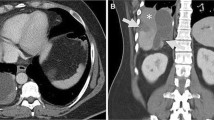Abstract
Diaphragmatic injury is an uncommon traumatic condition. It can be easily missed due to a lack of awareness by both clinicians and radiologists. A high index of suspicion is required for the establishment of an early diagnosis and prevention of life-threatening complications. Multidetector computed tomography (MDCT) is the modality of choice for the detection of diaphragmatic injury. In this review article, we illustrate the MDCT appearance of blunt and penetrating diaphragmatic injuries and emphasize the role of the emergency radiologist in detecting these entities.











Similar content being viewed by others
References
Reid J (1840) Diaphragmatic hernia produced by a penetrating wound. Edin Med Surg J 53:104–107
Simpson J, Lobo DN, Shah AB, Rowlands BJ (2000) Traumatic diaphragmatic rupture: associated injuries and outcome. Ann R Coll Surg Engl 82:97–100
Chughtai T, Ali S, Sharkey P et al (2009) Update on managing diaphragmatic rupture in blunt trauma: a review of 208 consecutive cases. Can J Surg 52:177–181
Bodanapally UK, Shanmuganathan K, Mirvis SE et al (2009) MDCT diagnosis of penetrating diaphragm injury. Eur Radiol 19:1875–1881
Spann JC, Nwariaku FE, Wait M (1995) Evaluation of video-assisted thoracoscopic surgery in the diagnosis of diaphragmatic injuries. Am J Surg 170:628–630
Desir A, Ghaye B (2012) CT of blunt diaphragmatic rupture. Radiographics 32:477–498
Leppäniemi A, Haapiainen R (2003) Occult diaphragmatic injuries caused by stab wounds. J Trauma 55(4):646–650
Meyers BF, McCabe CJ (1993) Traumatic diaphragmatic hernia. Occult marker of serious injury. Ann Surg 218(6):783–790
Rees O, Mirvis SE, Shanmuganathan K (2005) Multidetector-row CT of right hemidiaphragmatic rupture caused by blunt trauma: a review of 12 cases. Clin Radiol 60:1280–1289
Sliker CW (2006) Imaging of diaphragm injuries. Radiol Clin North Am 44:199–211
Bergeron E, Clas D, Ratte S et al (2002) Impact of deferred treatment of blunt diaphragmatic rupture: a 15-year experience in six trauma centers in Quebec. J Trauma 52:633–640
Gelman R, Mirvis SE, Gens D (1991) Diaphragmatic rupture due to blunt trauma: sensitivity of plain chest radiographs. AJR Am J Roentgenol 156:51–57
Shanmuganathan K, Killeen K, Mirvis SE, White CS (2000) Imaging of diaphragmatic injuries. J Thorac Imaging 15:104–111
Clarke DL, Greatorex B, Oosthuizen GV, Muckart DJ (2009) The spectrum of diaphragmatic injury in a busy metropolitan surgical service. Injury 40:932–937
Hammer MM, Flagg E, Mellnick VM et al (2013) Computed tomography of blunt and penetrating diaphragmatic injury: sensitivity and inter-observer agreement of CT signs. Emerg Radiol 21:143–149
Perlman SJ, Rogers LF, Mintzer RA, Mueller CF (1984) Abnormal course of nasogastric tube in traumatic rupture of left hemidiaphragm. AJR Am J Roentgenol 142:85–88
Murray JG, Caoili E, Gruden JF et al (1996) Acute rupture of the diaphragm due to blunt trauma: diagnostic sensitivity and specificity of CT. AJR Am J Roentgenol 166:1035–1039
Desser TS, Edwards B, Hunt S et al (2010) The dangling diaphragm sign: sensitivity and comparison with existing CT signs of blunt traumatic diaphragmatic rupture. Emerg Radiol 17:37–44
Dreizin D, Borja MJ, Danton GH et al (2013) Penetrating diaphragmatic injury: accuracy of 64-section multidetector CT with trajectography. Radiology 268:729–737
Nchimi A, Szapiro D, Ghaye B et al (2005) Helical CT of blunt diaphragmatic rupture. AJR Am J Roentgenol 184:24–30
Chen HW, Wong YC, Wang LJ et al (2010) Computed tomography in left-sided and right-sided blunt diaphragmatic rupture: experience with 43 patients. Clin Radiol 65:206–212
Restrepo CS, Eraso A, Ocazionez D et al (2008) The diaphragmatic crura and retrocrural space: normal imaging appearance, variants, and pathologic conditions. Radiographics 28:1289–1305
Naidich DP, Megibow AJ, Ross CR et al (1983) Computed tomography of the diaphragm: normal anatomy and variants. J Comput Assist Tomogr 7:633–640
Killeen K, Mirvis SE, Shanmuganathan K (1999) Helical CT of diaphragmatic rupture caused by blunt trauma. AJR Am J Roentgenol 173:1611–1616
Bergin D, Ennis R, Keogh C et al (2001) The “dependent viscera” sign in CT diagnosis of blunt traumatic diaphragmatic rupture. AJR Am J Roentgenol 177:1137–1140
Leung JC, Nance ML, Schwab CW, Miller WT Jr (1999) Thickening of the diaphragm: a new computed tomography sign of diaphragm injury. J Thorac Imaging 14:126–129
Larici AR, Gotway MB, Litt HI et al (2002) Helical CT with sagittal and coronal reconstructions: accuracy for detection of diaphragmatic injury. AJR Am J Roentgenol 179:451–457
Conflict of interest
The authors declare no conflict of interest.
Author information
Authors and Affiliations
Corresponding author
Rights and permissions
About this article
Cite this article
Patlas, M.N., Leung, V.A., Romano, L. et al. Diaphragmatic injuries: why do we struggle to detect them?. Radiol med 120, 12–20 (2015). https://doi.org/10.1007/s11547-014-0453-5
Received:
Accepted:
Published:
Issue Date:
DOI: https://doi.org/10.1007/s11547-014-0453-5




